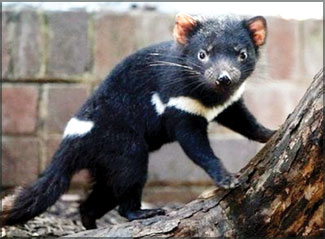Tasmanian devils threatened by cancer
The Tasmanian devil, a ferocious, snarling fox-sized marsupial, is in
danger of going extinct because of a contagious (infectious) facial
cancer.
In the meantime, its biggest rival - the European fox - is thriving,
and may become so dominant that the devil never comes back. Scientists
now want to build a double fence standing more than three feet tall to
stop the cancer's relentless (persistent) spread toward the rugged
northwest of the island, home to disease-free devils and World
Heritage-listed rain forest. Devils spread the cancer when they bite
each other during mating or squabbles over food.
But for any chance of success, the fences would have to be completed
within two years, said Hamish McCallum, the senior scientist in the
devil rescue programme. He predicts the devil will go extinct in the
wild within 20 years.
 The Australian island state of Tasmania is the only natural home for
the world's largest marsupial carnivore, made notorious by its Looney
Tunes cartoon namesake Taz. Its Latin name is Sarcophilus harrisii, or
"Harris' meat lover," after the scientist who first studied devils. The Australian island state of Tasmania is the only natural home for
the world's largest marsupial carnivore, made notorious by its Looney
Tunes cartoon namesake Taz. Its Latin name is Sarcophilus harrisii, or
"Harris' meat lover," after the scientist who first studied devils.
Scientists had hoped to find a genetic solution to the disease
through Cedric, a young devil who showed signs of natural immunity in
laboratory tests. But last month Cedric contracted a second, mutated
strain of the cancer.
Warner Bros., which owns Taz, and CNN founder Ted Turner, who started
the Cartoon Network, are helping the Australian and Tasmanian
governments bankroll (fund) the fight against the disease.
In the past three years, Australian zoos have bred 170 devils as
"insurance populations." Plans to establish a wild colony on uninhabited
Maria Island off Tasmania are controversial because of fears that devils
could endanger rare birds and beetles.
The Tasmanian government says it is considering offshore islands as
well as fenced areas up to 12 miles long, but its first priority is the
populations in mainland zoos.
McCallum, professor of wildlife research at the University of
Tasmania, said the only fence precedent (example) he knew of was in
South Africa, where the Kruger National Park was fenced on its southern
and western borders in 1961 to prevent foot-and-mouth disease spreading
from wildlife to cattle. The Tasmanian fence would be built in selective
areas, such as some corners or a peninsula.
"This isn't going to be a huge barrier like the Berlin Wall across
all of Tasmania," McCallum said.
Government wildlife biologist Nick Moonie noted that fences would
also trap other animals such as wallabies and echidnas, some of which
may need to move or migrate. Moonie, who advises both the devil rescue
and fox eradication programmes, suspects cancer won't wipe out devils,
but foxes just might.
- AP
|


